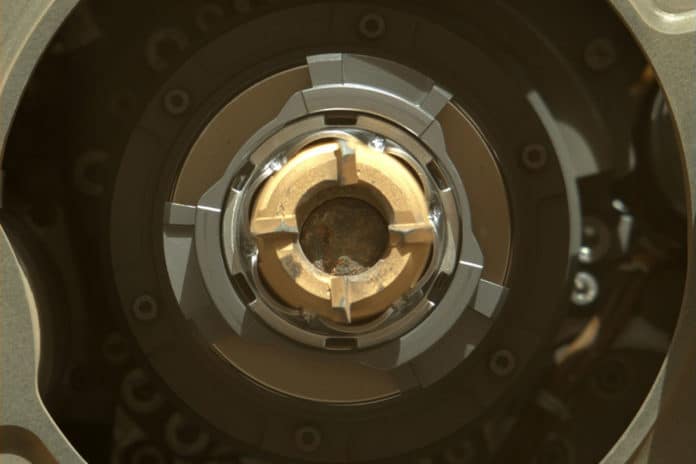NASA’s Perseverance rover managed on its second attempt to collect the first Martian rock drill sample for an (eventual) return to Earth. The agency has released an image of the retrieved sample – taken by the Mastcam-Z camera on September 1, 2021 – the mission’s 190th sol, or Martian day.
The recent confirmation comes after NASA’s first unsuccessful attempt, on August 5, which they called Roubion, was on one of the flat polygonal-shaped rocks that they have seen all along the rover’s traverse so far. But the rock it drilled that day turned out to be surprisingly soft, crumbling into bits that didn’t make it into the designated tube.
The new image shows a sample of Mars rock inside the sample tube. The mission team members announced Thursday that the new image was taken after coring concluded but prior to an operation that vibrates the drill bit and tube to clear the tube’s lip of any residual material.
The bronze-colored outer ring is the coring bit. The lighter-colored inner-ring is the open end of the sample tube, and inside is a rock core sample slightly thicker than a pencil. A portion of the tube’s serial number – 266 – can be seen on the top side of the tube’s wall.
Additional images taken after the arm completed sample acquisition were inconclusive due to poor sunlight conditions. Along with the released image, NASA ordered Perseverance to take several more images under better lighting for more confirmation of the core’s presence before the sample processing continues.
Subsequent NASA missions, in cooperation with the European Space Agency, would send spacecraft to Mars to collect these sealed samples from the surface and return them to Earth for in-depth analysis.
Perseverance’s mission includes searching for signs of ancient microbial life, collecting data on the planet’s past climate and geology, paving the way for the Red Planet’s human exploration, and being the first mission to collect and cache Martian rock and regolith (broken rock and dust).
The rover landed on Mars on February 18 with the Ingenuity Mars helicopter in the bowels. The small helicopter has its own program. It is not equipped with scientific instruments, and its only task is to test the possibility of using similar flying devices in the future when examining the surface of extraterrestrial bodies.
The machine exceeded the expectations of experts and has already completed 11 successful flights, during which, among other things, it took a number of shots of the terrain from the air. The images are also used by scientists when planning the Perseverance route.
